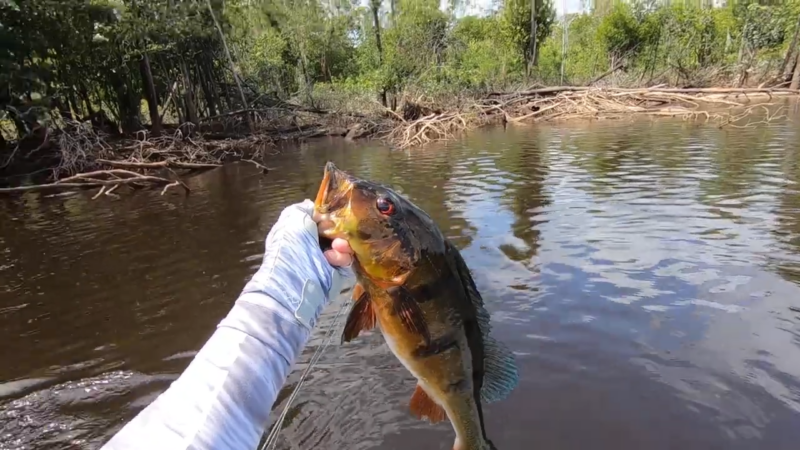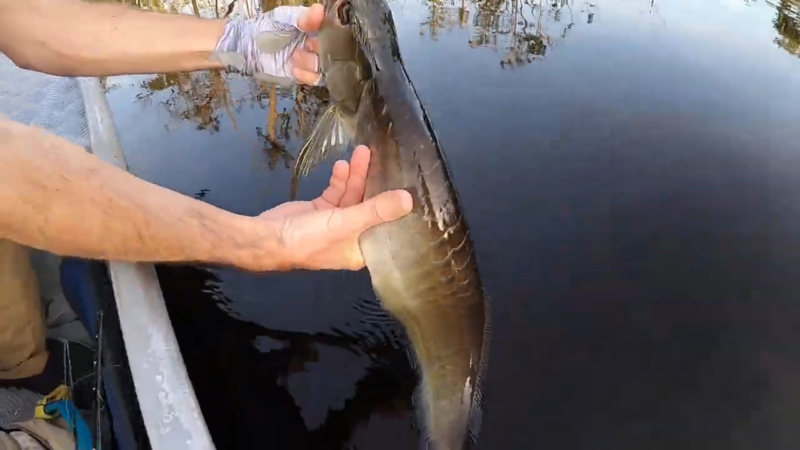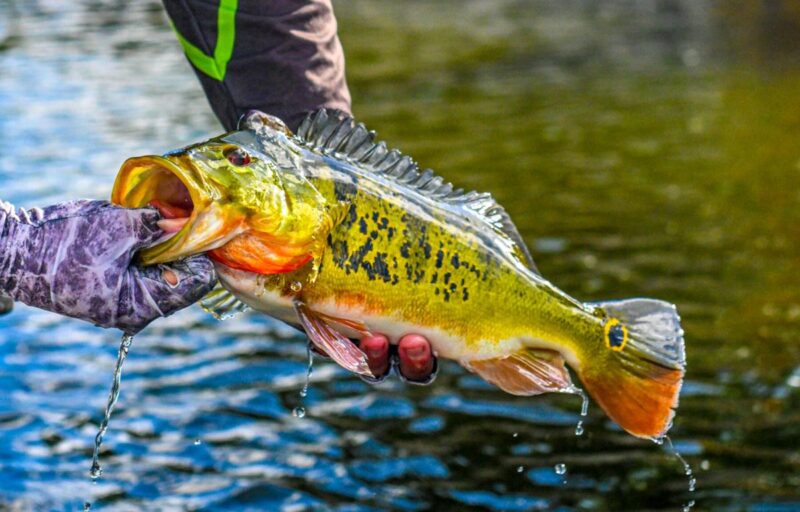Fishing for peacock bass can be tricky—they don’t always stay in the same spot or respond to the same tactics. Depending on the weather and water clarity, they can either be hiding in the shade or roaming around looking for food. Understanding how these conditions affect their behavior can make a huge difference in your catch rate.
That’s why I prepared some of the most important tips I learned from my own experience.
1. Know Their Characteristics and Behavior
Peacock bass aren’t your average freshwater fish. Originating from South America, specifically the Amazon River basin, they’ve made their way to various parts of the world, including Florida and Hawaii. Recognizable by their vibrant colors and distinctive “eye spot” near the tail, they’re not just a feast for the eyes—they’re formidable fighters too.
Behavior traits to keep in mind:
- Aggressive Predators: Peacock bass are hunters by nature. They’re known to ambush their prey, striking with incredible speed and force.
- Territorial Nature: They are highly territorial, especially during their spawning season. This trait makes them more likely to strike at anything that enters their domain.
- Preference for Warm Water: They thrive in warm temperatures. You’re likely to find them near the surface or in shallow waters, basking in the warmth.
2. Go Fishing In the Morning

Peacock bass are most active during early morning and late afternoon when the temperatures are slightly cooler. Midday fishing can be challenging due to their tendency to go deeper or hide in shaded areas to avoid the scorching heat.
| Ideal Locations | Description |
| Structure and Cover | Areas with submerged structures such as rocks, logs, or man-made debris. Peacock bass hide in these spots, waiting to ambush prey. |
| Shallow Waters | Close to the shore, particularly near overhanging trees or vegetation. These areas provide cover and a steady source of food. |
3. Gear Up

Peacock bass are strong, so your equipment needs to be up to the task.
- Rod and Reel: A medium to medium-heavy rod with a fast action tip paired with a spinning or baitcasting reel works wonders. This setup provides the strength needed for the fight while allowing for accurate casting.
- Line: A 20-30 lb braided line is perfect. It offers the sensitivity needed to feel the bites and the strength to handle the powerful runs of peacock bass.
Go-To Lures
Peacock bass are visual predators, so lures that mimic their prey’s movement are ideal. Here are some top choices:
| Lure Type | Description | Best Uses | Recommended Colors |
| Topwater Lures | Popper lures, stick baits, and propeller baits. | Surface action, attracting explosive strikes. | Natural shades, or colors that stand out against the sky. |
| Crankbaits & Jerkbaits | Ideal for covering different depths. Effective for mimicking injured baitfish. | Mid-depths, open water, and near structures. | Bright colors like chartreuse, orange, and yellow. |
| Soft Plastics | Flukes, swim baits, and worms can be rigged weedless. | Heavy cover areas, mimicking prey in hiding. | Natural colors like green, brown, and silver. |
4. Master Techniques – Casting, Retrieving, and Presentation
You’re casting and retrieving technique can make or break your fishing day. Peacock bass is reactive, so how you present your lure is crucial.
Accuracy Over Distance
Focus on placing your lure accurately near structures, cover, or drop-offs. Peacock bass often strikes immediately after the lure lands, so a precise cast is essential.
Stay Low and Quiet
Avoid making too much noise or splashing during casting. They can be easily spooked by sudden movements or loud sounds.
Retrieving Techniques
- Fast and Erratic: Peacock bass respond well to fast, erratic movements that mimic a distressed fish. Vary your retrieval speed and add quick twitches to entice strikes.
- Pause and Go: Another effective technique is the stop-and-go method. Retrieve for a few seconds, then pause. Typically, the strike comes during the pause when the lure appears vulnerable.
5. Wet Your Hands Before Touching the Fish

After a thrilling fight, handling peacock bass properly is important, especially if you’re practicing catch and release. Before touching the fish, wet your hands to avoid removing their protective slime coat. Use both hands—one under the belly and one near the tail—to support the fish. Avoid holding them solely by the lip, as it can damage their jaw.
Quick Release
Minimize air exposure. Keep the fish in the water as much as possible. If you need to take a picture, be quick and gentle. Revive before release. Hold the fish upright in the water and gently move it back and forth to help it regain strength before releasing.
6. Read the Water and Adapt to Conditions
Each fishing trip is unique. Factors like weather, water clarity, and temperature can affect peacock bass behavior.
| Condition | Recommended Strategy |
| Sunny Days | Fish in shaded areas or near overhanging vegetation where peacock bass might be hiding. |
| Cloudy or Overcast | Fish are more active and can be found in open water. The ideal time to use top water lures. |
| Clear Water | Use natural-colored lures such as green, brown, or silver to mimic local bait fish. |
| Muddy or Stained Water | Choose bright, flashy lures like chartreuse or orange to attract fish in low visibility. |
Final Thoughts
Catching peacock bass is about knowing where they hang out and what lures grab their attention. Paying attention to the weather and water clarity can help you figure out their mood and where they’re most likely to strike. By adjusting your strategy based on these conditions, you’ll have a much better chance of landing one of these awesome fish.
Keep these tips in mind and get ready for some exciting catches!

